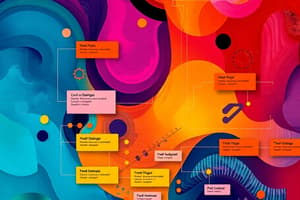Podcast
Questions and Answers
What is the primary focus of model-driven engineering (MDE)?
What is the primary focus of model-driven engineering (MDE)?
- Testing software in real-time environments
- Developing programs directly
- Generating models as principal outputs (correct)
- Creating hardware prototypes
Which of the following is NOT a state of the microwave oven as described in the content?
Which of the following is NOT a state of the microwave oven as described in the content?
- Disabled
- Waiting
- Error (correct)
- Operation
What stimulus is represented by the user pressing the full-power button on the microwave oven?
What stimulus is represented by the user pressing the full-power button on the microwave oven?
- Half power
- Door closed
- Timer
- Full power (correct)
One advantage of model-driven engineering (MDE) is that it allows for...
One advantage of model-driven engineering (MDE) is that it allows for...
In the context of model-driven architecture, what does MDE primarily enable?
In the context of model-driven architecture, what does MDE primarily enable?
Which of the following statements about MDE is true?
Which of the following statements about MDE is true?
What does the 'Enabled' state of the microwave oven indicate?
What does the 'Enabled' state of the microwave oven indicate?
Which is a possible drawback of adopting model-driven engineering?
Which is a possible drawback of adopting model-driven engineering?
What is a computation independent model (CIM) primarily used for?
What is a computation independent model (CIM) primarily used for?
Which of the following is NOT a disadvantage of Model-Driven Engineering (MDE)?
Which of the following is NOT a disadvantage of Model-Driven Engineering (MDE)?
What is the primary benefit of generating code automatically in MDE?
What is the primary benefit of generating code automatically in MDE?
What is the distinguishing feature of a platform independent model (PIM)?
What is the distinguishing feature of a platform independent model (PIM)?
What approach does Model-Driven Architecture (MDA) emphasize?
What approach does Model-Driven Architecture (MDA) emphasize?
Which type of model transforms a platform-independent model for specific platforms?
Which type of model transforms a platform-independent model for specific platforms?
Which of the following statements accurately describes Model-Driven Engineering (MDE)?
Which of the following statements accurately describes Model-Driven Engineering (MDE)?
What might outweigh the savings from generating code in MDE?
What might outweigh the savings from generating code in MDE?
What is one of the main claims of MDA developers regarding its application in software development?
What is one of the main claims of MDA developers regarding its application in software development?
What is a significant limitation regarding the adoption of MDA?
What is a significant limitation regarding the adoption of MDA?
Why might the arguments for platform-independence in MDA be considered valid primarily for large systems?
Why might the arguments for platform-independence in MDA be considered valid primarily for large systems?
Which of the following points to a common misconception about model-driven engineering?
Which of the following points to a common misconception about model-driven engineering?
What challenge does MDA face due to the adoption of agile methods?
What challenge does MDA face due to the adoption of agile methods?
In the context of MDA, what is a concern associated with developing tools for long-lifetime systems?
In the context of MDA, what is a concern associated with developing tools for long-lifetime systems?
Which aspect is considered more significant than implementation in most complex systems?
Which aspect is considered more significant than implementation in most complex systems?
What is a potential issue with extensive up-front modeling in agile development?
What is a potential issue with extensive up-front modeling in agile development?
Flashcards
Model-Driven Engineering (MDE)
Model-Driven Engineering (MDE)
A software engineering approach using models to represent systems at different levels of abstraction to automate code generation.
Model Driven Architecture (MDA)
Model Driven Architecture (MDA)
A model-focused approach to software design using UML models to describe a system, with the goal to create working code without manual intervention.
Computation Independent Model (CIM)
Computation Independent Model (CIM)
A model of a system that focuses on important domain abstractions without specifying operations or implementation details.
Platform Independent Model (PIM)
Platform Independent Model (PIM)
Signup and view all the flashcards
Platform Specific Model (PSM)
Platform Specific Model (PSM)
Signup and view all the flashcards
Software Abstraction
Software Abstraction
Signup and view all the flashcards
Automated Code Generation
Automated Code Generation
Signup and view all the flashcards
UML models
UML models
Signup and view all the flashcards
Layered PSM
Layered PSM
Signup and view all the flashcards
MDA Transformations
MDA Transformations
Signup and view all the flashcards
Multiple PSMs
Multiple PSMs
Signup and view all the flashcards
Agile and MDA
Agile and MDA
Signup and view all the flashcards
Automated Code Generation in MDA
Automated Code Generation in MDA
Signup and view all the flashcards
MDA Adoption Limits
MDA Adoption Limits
Signup and view all the flashcards
MDA Abstractions
MDA Abstractions
Signup and view all the flashcards
MDA vs Agile Popularity
MDA vs Agile Popularity
Signup and view all the flashcards
Statechart
Statechart
Signup and view all the flashcards
Microwave Oven States
Microwave Oven States
Signup and view all the flashcards
Stimulus
Stimulus
Signup and view all the flashcards
UML
UML
Signup and view all the flashcards
State Diagram (Microwave)
State Diagram (Microwave)
Signup and view all the flashcards
System Modeling
System Modeling
Signup and view all the flashcards
Model Output (MDE)
Model Output (MDE)
Signup and view all the flashcards
Study Notes
System Modeling
- System modeling is the process of creating abstract models of a system. Each model shows a different perspective of the system.
- System models can be used to understand the system's functionality. They are used to communicate with clients.
- Models can be incomplete or incorrect, but still support discussions about the system.
- Models are used to document and describe existing systems, or to describe how a proposed system will function.
- Models don't need to be complete, just accurate enough to communicate function
Topics Covered
- Context models: Display the environment of the system (what surrounds the system and what other systems it interacts with)
- Interaction models: Show interactions between the system and other systems or components. Example diagrams are use cases and sequence diagrams
- Structural models: Show the internal structure of the system. Example diagrams are class diagrams, and more complex object class diagrams (e.g., an aggregation diagram).
- Behavioral models: Display how the system behaves and reacts to external and internal events. Example diagrams are activity diagrams, state diagrams
UML Diagram Types
- Activity diagrams: Show the activities involved in processing data.
- Use case diagrams: Show interactions between a system and its environment (e.g., actors).
- Sequence diagrams: Show the sequence of interactions between actors and objects in the system.
- Class diagrams: Represent the classes and objects in the system and relationships between them (e.g., "Patient record" class interacts with "Patient" class).
- State diagrams: Show how a system reacts to events by moving through different states.
System Perspectives
- External perspective: Models the context or environment of the system.
- Interaction perspective: Models interactions between a system and its environment, or between components within the system.
- Structural perspective: Models the organization or structure of the system, and the organization of the data processed.
- Behavioral perspective: Models the dynamic behavior of a system in reaction to events.
Context Models
- Context models illustrate how a system operates in relation to other systems.
- Social and organizational concerns may influence how the boundary of the system is defined.
- Architectural models illustrate the relationship between the current system and other systems.
System boundaries
- System boundaries define what is inside and outside a system.
- They can determine the scope of the system and requirements.
- Defining system boundaries is a complex political issue.
Process Perspective
- Context models describe the environment, not how the system is used.
- Process models show how systems are used within broader business processes.
- UML activity diagrams can be used to define business process models.
Model-driven engineering (MDE)
- MDE is an approach to software development where models are the main output.
- Models often become the basis for programming instructions / code.
- Model-driven engineering focuses on developing models rather than immediately developing code.
Usage of Model-Driven Engineering
- MDA is still a new approach to software development.
- Proponents find value in the automation from models to code.
- Cons: Models are not always helpful immediately and tools in development are not widely available.
- Concerns: Implementation complexity; security; testing; dependability; legacy system compatibility.
MDA Transformations
- Model-driven architecture transitions the model from a higher-level view to a lower-level view, ultimately to executable code
- This involves translators that can achieve these transitions. These translators use various patterns and rules, based on programming language specifications.
Multiple Platform-Specific Models
- Multiple platforms will necessitate multiple translators.
Agile Methods and MDA
- MDA is meant to work with agile methods but struggles with the extensive upfront modeling required.
Adoption of MDA
- Tools are limited. Tool adaptation is resource intensive
- Modeling is not necessarily suited to all systems; there are advantages based on context.
- Concerns: Maintainability, complexity of transitioning models.
Key Points (Summary)
- Models abstract systems by ignoring implementation details including all different perspectives.
- Models can be used together to build a comprehensive system understanding.
- UML diagrams are important for visualizing and describing systems in their various states, including interaction models, object class models, and behavioral models.
- MDA is an approach toward automated, model-to-code generation, but still faces practical concerns for acceptance into broader development paradigms.
Studying That Suits You
Use AI to generate personalized quizzes and flashcards to suit your learning preferences.




